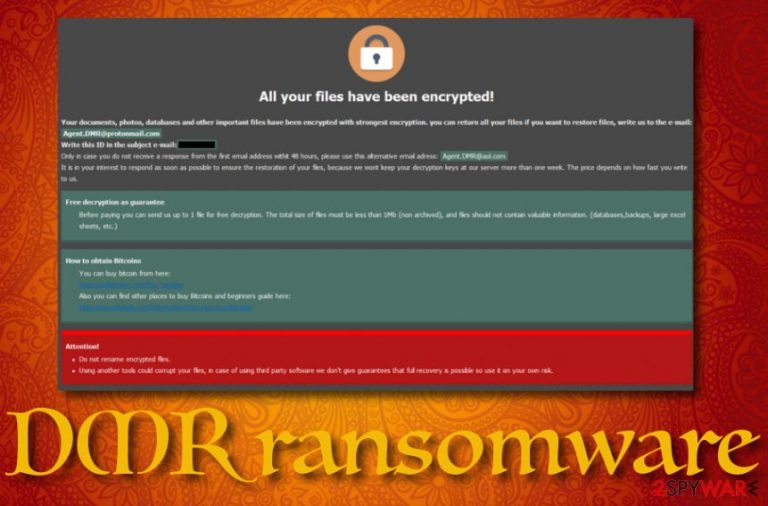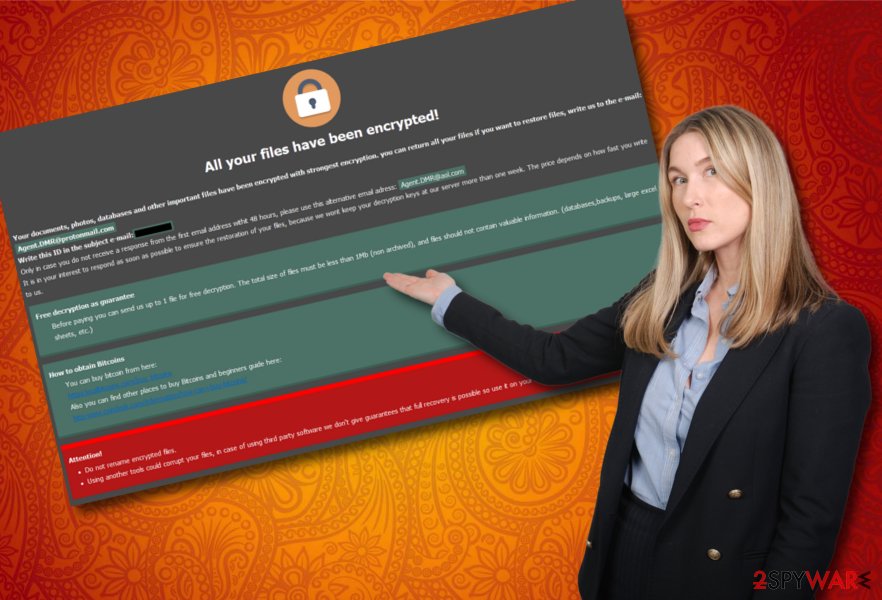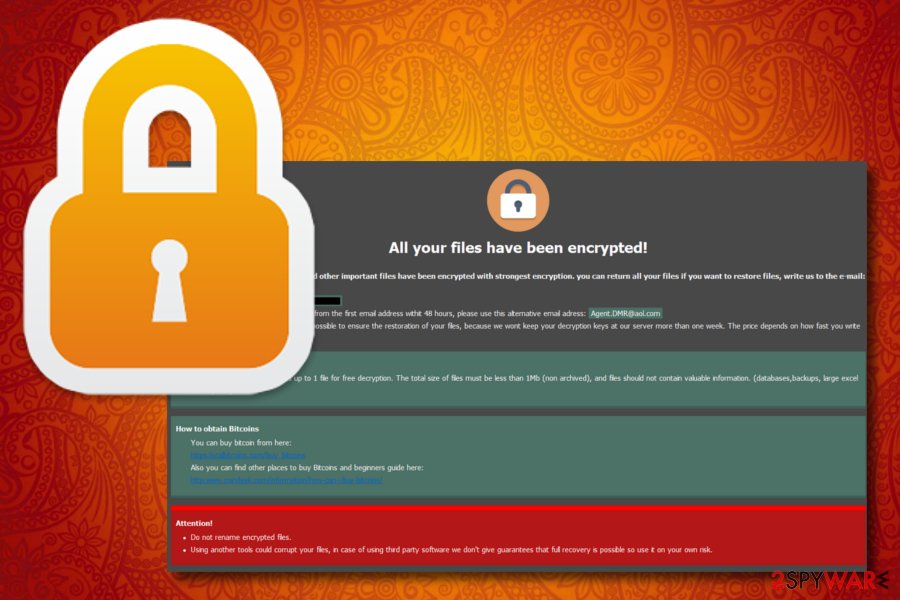DMR ransomware (Improved Instructions) - Quick Decryption Solution
DMR virus Removal Guide
What is DMR ransomware?
DMR ransomware – a file-locking parasite that has been detected by 48 AV engines

DMR ransomware, also known as DMR64 ransomware, is a newly-released malware that provides all information about the ransom demands in the !!! READ THIS !!!.hta message that is displayed in the HTML format. Here crooks urge for a Bitcoin ransom (the accurate sum is not described) in exchange for the decryption key for .DMR64 files. Agent.DMR@protonmail.com and Agent.DMR@aol.com are the crooks' email addresses where the second email is an alternative one if the hackers do not respond within 2 days via the first email address. We suggest not following the provided ransom demands as you might get lured into a scam and spend your money on receiving nothing instead of the key.
| Name | DMR ransomware/DMR64 ransomware |
|---|---|
| Type | Ransomware virus/ransom-demanding threat/file-locking malware |
| Extension | Once the ransomware runs the encryption module on all files found, it appends the .DMR64 extension to each filename |
| Note | All information about the ransom demands and conditions are written in the !!! READ THIS !!!.hta message that comes in the format of an HTML file |
| Ransom sum | Crooks do not provide an accurate sum of money that needs to be transferred in order to receive the decryption tool. However, these people demand Bitcoin cryptocurrency |
| Email(s) | The criminals provide Agent.DMR@protonmail.com and Agent.DMR@aol.com email addresses as a way to make contact. The first email address is the primary one while the second email is given if the crooks do not respond within 48 hours via the first one |
| Distribution | The most common distribution places of ransomware viruses are email spam, software cracks, malvertising, infectious hyperlinks, and malicious software updates |
| Removal | You should choose the automatical elimination option for DMR ransomware. Antimalware software is capable of spotting all infected locations and deleting all suspicious/malicious components from the system |
| Fix | If you have discovered any damaged components on your computer system, you can try fixing your machine with the help of FortectIntego software |
DMR ransomware offers to send the criminals one small file that does not include any important information such as big excel documents, backups, or various databases for free decryption as evidence of the decryption software's existence.
However, even if the cybercriminals have the decryption tool, that does not mean that these people will hand it over to you after the payment process. Regarding this, you should avoid paying any demanded ransom that comes from DMR64 ransomware as you might easily get scammed and left with no key at all.

Besides, you can see that DMR64 ransomware developers urge victims to purchase Bitcoin as these transfers are the only ones the crooks accept. Cryptocurrency transfers do not require any personally-identifiable information and this way the criminals can stay anonymous and the entire payment process remains safe and untracked.
If DMR ransomware has a more advanced module, it might be able to delete Shadow Volume Copies of encrypted data by executing specific commands via PowerShell. This way the malicious actors seek to harden the decryption process by using third-party tools. Additionally, the crooks threaten that other software would not work:
All your files have been encrypted!
Your documents, photos, databases and other important files have been encrypted with strongest encryption. you can return all your files if you want to restore files, write us to the e-mail: Agent.DMR@protonmail.com
Write this ID in the subject e-mail:1E857D00
Only in case you do not receive a response from the first email address withit 48 hours, please use this alternative email adress: Agent.DMR@aol.com
It is in your interest to respond as soon as possible to ensure the restoration of your files, because we wont keep your decryption keys at our server more than one week. The price depends on how fast you write to us.
Free decryption as guarantee
Before paying you can send us up to 1 file for free decryption. The total size of files must be less than 1Mb (non archived), and files should not contain valuable information. (databases,backups, large excel sheets, etc.)
How to obtain Bitcoins
You can buy bitcoin from here:
https:localbitcoins.com/buy_bitcoins
Also you can find other places to buy Bitcoins and beginners guide here:
http:www.coindesk.com/information/how-can-i-buy-bitcoins/
Attention!
Do not rename encrypted files.
Using another tools could corrupt your files, in case of using third party software we don't give guarantees that full recovery is possible so use it on your own risk.
DMR ransomware might also inject specific tasks that allow scanning the computer for encryptable files once in a while. So, if you are infected with this malware, DO NOT load any new files on the system as they will also get encrypted. Another thing that the virus might ensure is its automatical startup process whenever the computer is booted.
However, these are just a few features that DMR64 ransomware can be capable of. Threats like this can also modify the Windows hosts file to prevent the user from visiting security-related networks and collecting valuable information regarding the parasite's removal process and alternative data recovery solutions.
Continuously, DMR ransomware can bring other malicious programs to your computer. These can turn out to be anything – trojans, worms, cryptocurrency miners, etc. Where is one virus, there will usually appear another cyber threat.
Regarding this fact, you should not postpone DMR ransomware removal. Once you see the first signs of the infection (the ransom note and the .DMR64 encryption appendix), you have to take immediate action. Install a trustworthy and strong antimalware program that will be able to detect and eliminate the malware properly.
When you remove DMR ransomware, there might remain some damaged components on your Windows computer system. If this happens, you should perform a fixing process on your machine. Our recommendation would be to try FortectIntego as it might help you with the repair task.

Experts discovered that ransomware is most likely to get distributed via email spam
Security specialists from Virusai.lt have made an investigation on the most popular ransomware distribution sources and the results showed that these parasites are most likely to distribute via email spam messages. Criminals pretend to come from reliable shipping organizations such as FedEx, healthcare, or banking firms and deliver random victims letters that include infectious hyperlinks or malicious attachments clipped directly to the message itself.
When opening email messages, always identify the sender, read throughout the content carefully and search for possible grammar/style mistakes. Continuously, do not click on any suspicious hyperlinks that are included in a message you were not expecting to receive and do not open any clipped attachments without scanning them with antimalware as there might be malicious strings secretly hidden and waiting for a user to step on them.
However, email spam is not the only ransomware distribution source. These virtual parasites can get delivered through software cracks that are illegitimately put up on peer-to-peer networks such as The Pirate Bay, BitTorrent, and eMule. A piece of advice would be to download and install all of your preferred products and services from original sources only. This way you can avoid unexpected infiltration of malicious programs.
Furthermore, ransomware can get spread via malvertising, malicious software updates, and infectious links that are posted on third-party networks. Secondary websites always carry the risk of secret malware infections as they do not include required protection. What you should do is make sure that your computer is secured at a higher level. For this purpose, install reliable antimalware protection and make sure once in a while that the program is operating properly.
DMR ransomware elimination guide + data recovery solutions
DMR ransomware removal is a thorough process that needs to be completed carefully and by paying a lot of attention. Regarding this fact, you should employ reliable software that will carry out the task for you. Manual elimination might bring only more damage if you are not a highly-experienced user. Besides, no person has the type of efficient and safe skills as antimalware software holds. This makes antivirus programs more capable of handling the removal process.
Continuously, after you remove DMR ransomware, you should check if there are some damaged system locations in your Windows computer. For this purpose, employ software such as SpyHunter 5Combo Cleaner or Malwarebytes and perform a full computer checkup process. Afterward, look through the scan results and if any damaged objects are discovered, you can try fixing your machine and its components with system repair software such as FortectIntego or any other similar product.
When DMR64 ransomware has been successfully removed and all damage is repaired, you can start thinking about data recovery solutions. Keep in mind that it is not worth paying the demanded ransom price as you will face a big risk of getting scammed and left with no decryption tool at all. Rather than taking such risk, you should check the below-provided data recovery solutions some of which might appear helpful if completed as required.
Getting rid of DMR virus. Follow these steps
Manual removal using Safe Mode
To disable malicious activities on your Windows computer system, you need to boot your machine in Safe Mode with Networking. This mode can be accessed by completing the below-provided guiding steps:
Important! →
Manual removal guide might be too complicated for regular computer users. It requires advanced IT knowledge to be performed correctly (if vital system files are removed or damaged, it might result in full Windows compromise), and it also might take hours to complete. Therefore, we highly advise using the automatic method provided above instead.
Step 1. Access Safe Mode with Networking
Manual malware removal should be best performed in the Safe Mode environment.
Windows 7 / Vista / XP
- Click Start > Shutdown > Restart > OK.
- When your computer becomes active, start pressing F8 button (if that does not work, try F2, F12, Del, etc. – it all depends on your motherboard model) multiple times until you see the Advanced Boot Options window.
- Select Safe Mode with Networking from the list.

Windows 10 / Windows 8
- Right-click on Start button and select Settings.

- Scroll down to pick Update & Security.

- On the left side of the window, pick Recovery.
- Now scroll down to find Advanced Startup section.
- Click Restart now.

- Select Troubleshoot.

- Go to Advanced options.

- Select Startup Settings.

- Press Restart.
- Now press 5 or click 5) Enable Safe Mode with Networking.

Step 2. Shut down suspicious processes
Windows Task Manager is a useful tool that shows all the processes running in the background. If malware is running a process, you need to shut it down:
- Press Ctrl + Shift + Esc on your keyboard to open Windows Task Manager.
- Click on More details.

- Scroll down to Background processes section, and look for anything suspicious.
- Right-click and select Open file location.

- Go back to the process, right-click and pick End Task.

- Delete the contents of the malicious folder.
Step 3. Check program Startup
- Press Ctrl + Shift + Esc on your keyboard to open Windows Task Manager.
- Go to Startup tab.
- Right-click on the suspicious program and pick Disable.

Step 4. Delete virus files
Malware-related files can be found in various places within your computer. Here are instructions that could help you find them:
- Type in Disk Cleanup in Windows search and press Enter.

- Select the drive you want to clean (C: is your main drive by default and is likely to be the one that has malicious files in).
- Scroll through the Files to delete list and select the following:
Temporary Internet Files
Downloads
Recycle Bin
Temporary files - Pick Clean up system files.

- You can also look for other malicious files hidden in the following folders (type these entries in Windows Search and press Enter):
%AppData%
%LocalAppData%
%ProgramData%
%WinDir%
After you are finished, reboot the PC in normal mode.
Remove DMR using System Restore
To deactivate all malware-laden objects on your machine, you should opt for System Restore. You can activate the function by performing these instructions:
-
Step 1: Reboot your computer to Safe Mode with Command Prompt
Windows 7 / Vista / XP- Click Start → Shutdown → Restart → OK.
- When your computer becomes active, start pressing F8 multiple times until you see the Advanced Boot Options window.
-
Select Command Prompt from the list

Windows 10 / Windows 8- Press the Power button at the Windows login screen. Now press and hold Shift, which is on your keyboard, and click Restart..
- Now select Troubleshoot → Advanced options → Startup Settings and finally press Restart.
-
Once your computer becomes active, select Enable Safe Mode with Command Prompt in Startup Settings window.

-
Step 2: Restore your system files and settings
-
Once the Command Prompt window shows up, enter cd restore and click Enter.

-
Now type rstrui.exe and press Enter again..

-
When a new window shows up, click Next and select your restore point that is prior the infiltration of DMR. After doing that, click Next.


-
Now click Yes to start system restore.

-
Once the Command Prompt window shows up, enter cd restore and click Enter.
Bonus: Recover your data
Guide which is presented above is supposed to help you remove DMR from your computer. To recover your encrypted files, we recommend using a detailed guide prepared by 2-spyware.com security experts.If your files are encrypted by DMR, you can use several methods to restore them:
Try using Data Recovery Pro for file restoring purposes:
If the ransomware virus has locked some of your files, you have a chance of recovering them by employing this software.
- Download Data Recovery Pro;
- Follow the steps of Data Recovery Setup and install the program on your computer;
- Launch it and scan your computer for files encrypted by DMR ransomware;
- Restore them.
Activate Windows Previous Previous Versions feature for data recovery:
You can try using this software for restoring some of your files. However, note that this method might not work properly if you have not activated System Restore in the past.
- Find an encrypted file you need to restore and right-click on it;
- Select “Properties” and go to “Previous versions” tab;
- Here, check each of available copies of the file in “Folder versions”. You should select the version you want to recover and click “Restore”.
Shadow Explorer might be helpful with data restoring tasks:
If the ransomware virus did not eliminate the Shadow Volume Copies of your encrypted data, you can give this third-party tool a try.
- Download Shadow Explorer (http://shadowexplorer.com/);
- Follow a Shadow Explorer Setup Wizard and install this application on your computer;
- Launch the program and go through the drop down menu on the top left corner to select the disk of your encrypted data. Check what folders are there;
- Right-click on the folder you want to restore and select “Export”. You can also select where you want it to be stored.
Currently, cybersecurity experts are working on the DMR ransomware decryption key.
Finally, you should always think about the protection of crypto-ransomwares. In order to protect your computer from DMR and other ransomwares, use a reputable anti-spyware, such as FortectIntego, SpyHunter 5Combo Cleaner or Malwarebytes
How to prevent from getting ransomware
Do not let government spy on you
The government has many issues in regards to tracking users' data and spying on citizens, so you should take this into consideration and learn more about shady information gathering practices. Avoid any unwanted government tracking or spying by going totally anonymous on the internet.
You can choose a different location when you go online and access any material you want without particular content restrictions. You can easily enjoy internet connection without any risks of being hacked by using Private Internet Access VPN.
Control the information that can be accessed by government any other unwanted party and surf online without being spied on. Even if you are not involved in illegal activities or trust your selection of services, platforms, be suspicious for your own security and take precautionary measures by using the VPN service.
Backup files for the later use, in case of the malware attack
Computer users can suffer from data losses due to cyber infections or their own faulty doings. Ransomware can encrypt and hold files hostage, while unforeseen power cuts might cause a loss of important documents. If you have proper up-to-date backups, you can easily recover after such an incident and get back to work. It is also equally important to update backups on a regular basis so that the newest information remains intact – you can set this process to be performed automatically.
When you have the previous version of every important document or project you can avoid frustration and breakdowns. It comes in handy when malware strikes out of nowhere. Use Data Recovery Pro for the data restoration process.







